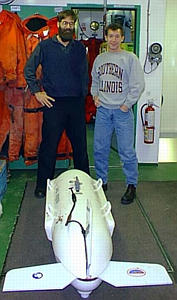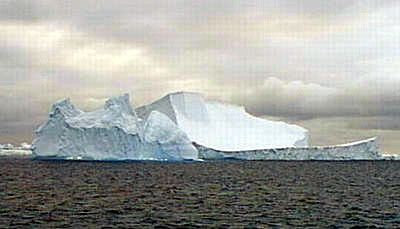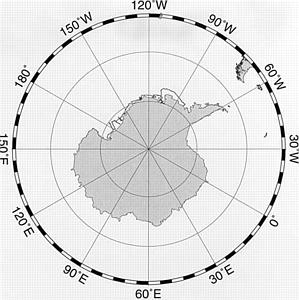
|
|
15 March, 1999
March 15, 1999
Hi from Eltanin Bay! We've been doing a multibeam survey for most of the
afternoon. We're trying to map the glacial drainage trough (depressed
area) of the continental shelf along the Bryan Coast. Eltanin Bay is a
major drainage basin for this part of the West Antarctic Ice Sheet.
Eltanin Bay is not usually accessable to ships due to heavy ice. It was
first mapped between 1961 and 1966 by the USGS from surveys and U.S. Navy
air photos. It was named for the United States Antarctic Research Program
oceanographic research ship, Eltanin, which made numerous research cruises
in the Southern Ocean.
About 20 minutes ago, we finished taking a piston core. This was the first
one we've taken in a couple of days. Everyone was ready to work and
anxious to get outside and play in the mud! Now, we are moving on toward
our next core site. Tonight will probably consist of more multibeam
surveys and piston cores. There is a possibility that they will conduct a
deep tow survey, depending on what the multibeam shows us. By late
tomorrow morning, we will leave Eltanin Bay and continue east toward
Marguerite Bay on the Antarctic Peninsula. It's about 250 miles to
Marguerite Bay, so our next transit will take approximately 24 hours.
Today, I would like to explain about two more Antarctic Support Associates
(ASA) employees that are working with us on our cruise. Peter Martin and
Kevin Bliss are the Electronics Technicians (ETs) aboard the Nathaniel B.
Palmer. ETs are responsible for the maintenance and operation of almost
any scientific gear that uses electricity. Peter grew up in New Mexico,
and graduated from the University of New Mexico in 1975 with a major in
Spanish and a minor in Philosophy. He returned to get his teaching license
in General Science, Math, and Spanish in 1977. After deciding that he
didn't want to remain in teaching, Peter was able to use his hobby of
amateur radios to find a job. He worked as a radio operator on ships for
seven years; first on merchant ships and then on Lamont-Doherty's
oceanographic research vessel, the Maurice Ewing. Eventually, the newer
Global Marine Distress and Safety System made radio operators unnecessary
on ships, so he had to look for a different job. In June, 1998, he applied
for a job with ASA, and was aboard the Nathaniel B. Palmer three weeks
later as an Electronics Technician. To Peter, it is a lot of fun to figure
out how each piece of equipment works -- how it is made, how it is put
together, and how it is operated. If he understands these things from the
beginning, it's a lot easier for him to fix them if something goes wrong.
Although this is his last cruise as an ASA employee, Peter really enjoys
both the diversity of his job and being at sea.
Kevin Bliss grew up in Streator, Illinois. Originally, he had assumed that
he would become a plumber and join his father's business. Sometime during
his junior or senior year of high school, however, he changed his mind and
decided that he wanted to go to college. After starting out in Mechanical
Engineering at a small private university, Kevin graduated with a B.S. in
Physics from Southern Illinois University in 1989. He later accepted a job
as an accelerator operator at Fermi Lab, where he worked for two years.
Kevin then decided that he wanted to live out west, and he moved to Fort
Collins, Colorado. He was a plumber for a short time, but low wages in the
area forced him to take a job at National Cash Register. While working at
NCR, Kevin had lots of spare time in which he taught himself computer
skills. As his skills improved, he sent out resumes . . . and one of them
was to ASA. Kevin was hired by ASA in 1994, and has been working for them
ever since. He spent three seasons (over 30 total months) at Palmer
Station as the science technician, and he's been working on Antarctic
research vessels (both the NBP and the Gould) since last July. Kevin
really likes the fact that he gets to work with many different pieces of
scientific equipment and find out how each one of them works. He also
loves the fact that his vacations from this job are in large chunks of
time. Kevin enjoys backpacking, rock climbing, and traveling. After we
leave the ship, Kevin will be working for one more cruise before his
vacation begins. This summer, Kevin hopes to spend some time hiking the
Appalachian Trail. So far, he has hiked the portions through Maine and New
Hampshire. In order to complete the entire trail, he will need about four
more months of hiking. In addition, he is planning to climb Acongaua, the
highest peak in the Southern Hemisphere, next January and February.
Yesterday's question was: "What are the aurora australis?" The common name
for the aurora australis is the Southern lights. They are like the
Northern lights, but they occur in the Southern Hemisphere. As you already
know, the Earth has a magnetic field around it. This magnetic field is
invisible, but when the solar wind (high-energy parcticles given off by the
sun) enters the magnetic field, the energy excites atoms, molecules, and
ions in the Earth's upper atmosphere. As these atoms, molecules, and ions
return to their lower energy state, spectacular displays of aurora occur.
These can be seen near both the North and the South Magnetic Poles.
Although lots of different colors can be seen during an auroral display,
the main colors usually seen are green, red, purple, and white. Oxygen
atoms usually emit the green and red colors, nitrogen gives off the purple
hues, and the mixture of green, red, and purple emissions may combine to
give a whitish appearance. Although I have been lucky enough to see the
aurora borealis (Northern lights) on two separate occasions while I was
traveling in the Northern United States, I have never seen the aurora
australis. To begin with, our skies have been very cloudy and gray -- we
haven't seen the stars either. Most of the scientists who are studying the
auroras conduct their research from Amundsen-Scott South Pole Station. At
the South Pole, the 9,327 feet elevation, combined with the permanent high
pressure system over the continent (making for clear skies), makes an ideal
location for a variety astronomical research projects. I'm not even sure
if the aurora australis are common or not right now, but you can be sure
that I'll write about it if we do see them! For tomorrow, we'll look at
another common question that I have seen quite a bit: "What are some of the
other birds that you find in Antarctica (besides penguins)? Don't hesitate
to write to me if you have any questions . . . I love getting the email!
Kim Giesting
Latitude: 72 degrees 52 minutes South
Longitude: 82 degrees 07 minutes West
Temperature: -2.9 degrees C
Barometer: 969.2 mb
Wind Speed: 16.3 knots
Wind Direction: 114 (from the Southeast)
Sunrise: 06:11
Sunset: 19:13

Peter and Kevin are standing next to the "fish" that they did such a great job of repairing! The "fish" is the instrument that we use to conduct our deep tow side scan sonar surveys. It is towed about two and a half kilometers behind the ship and about 100 meters off the seafloor.

Another great iceberg from "iceberg alley."

Here's a map of Antarctica with the longitude lines marked. You can see our track line around the top of the picture. Sometimes it looks like we go over the land . . . but actually the map shows ice boundaries (and they have moved).
Contact the TEA in the field at
.
If you cannot connect through your browser, copy the
TEA's e-mail address in the "To:" line of
your favorite e-mail package.
|
